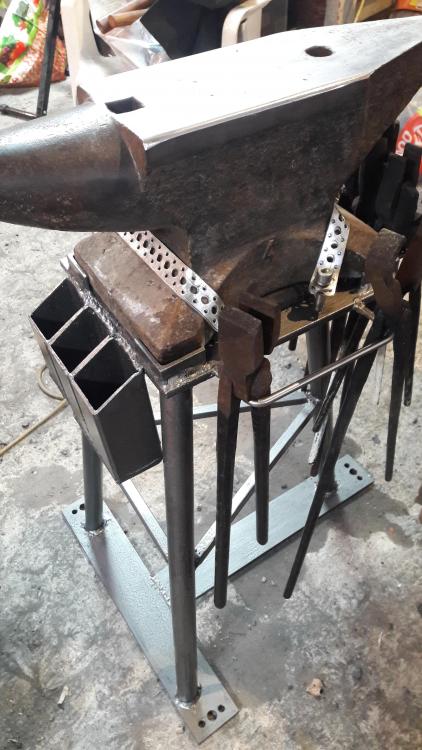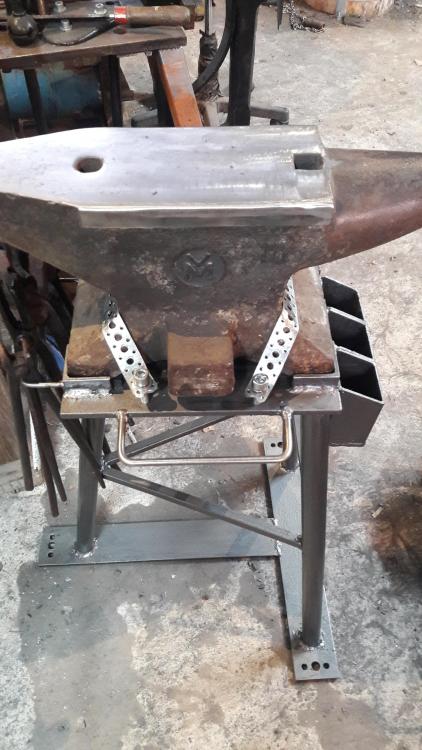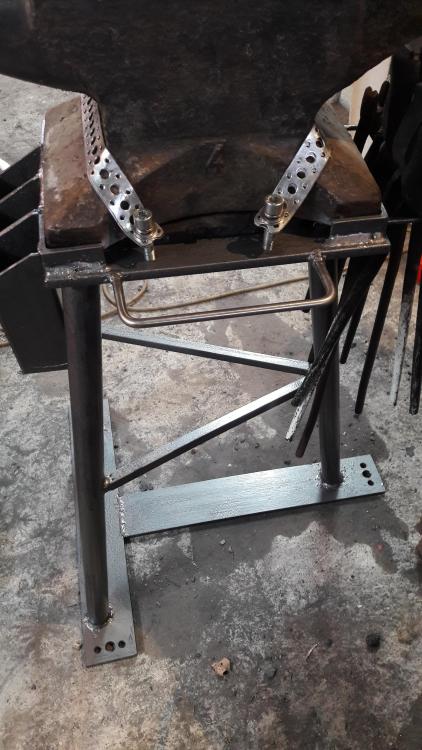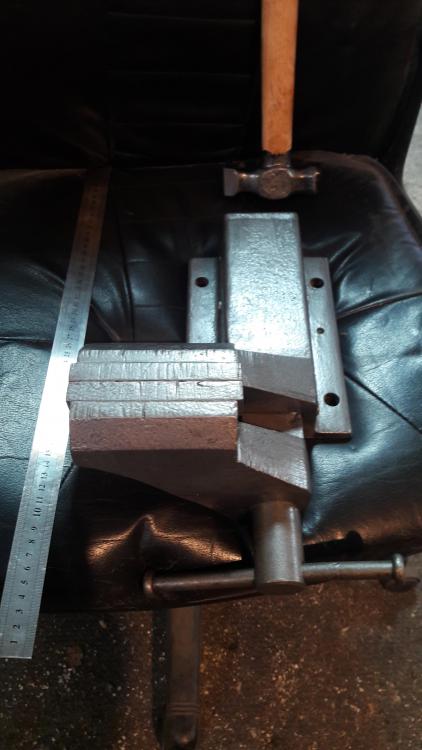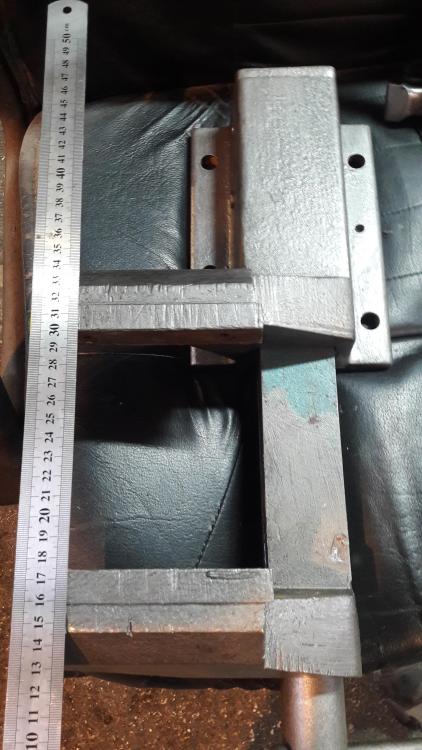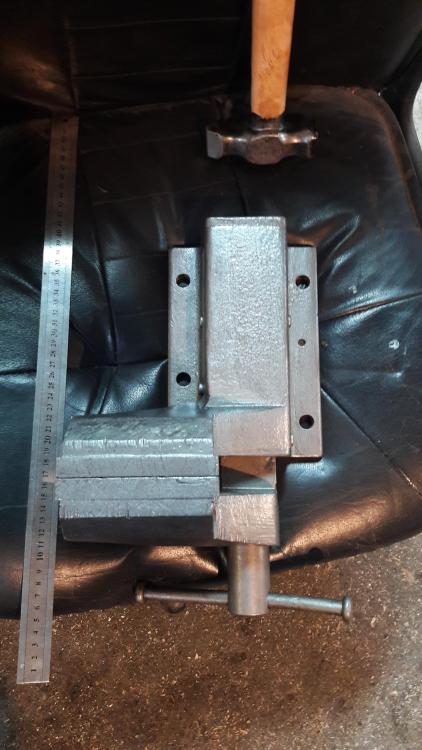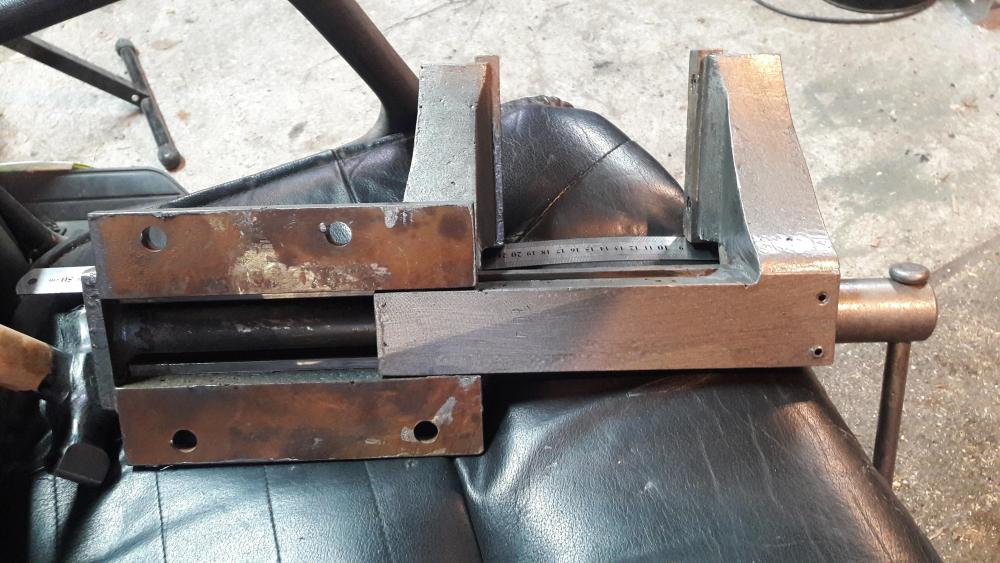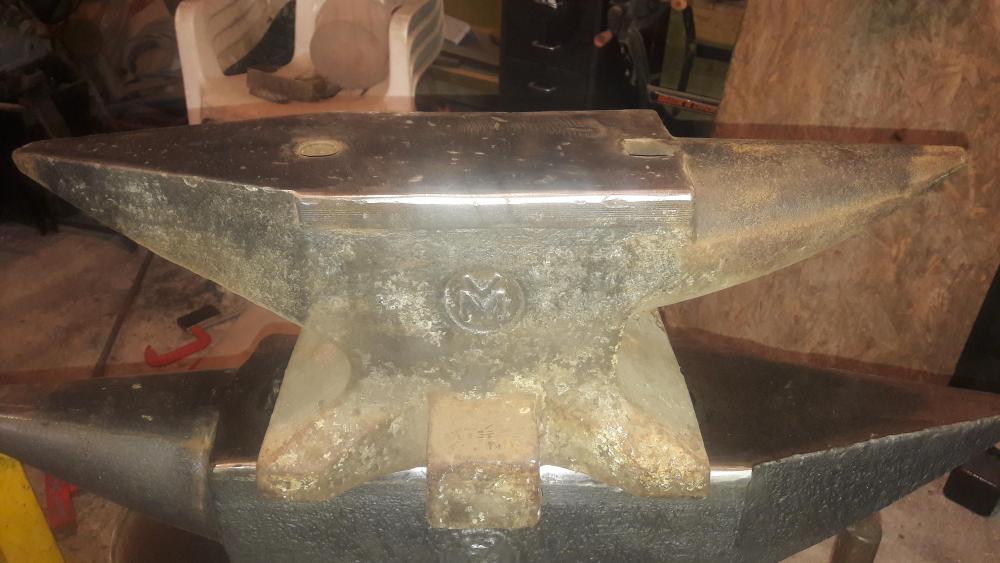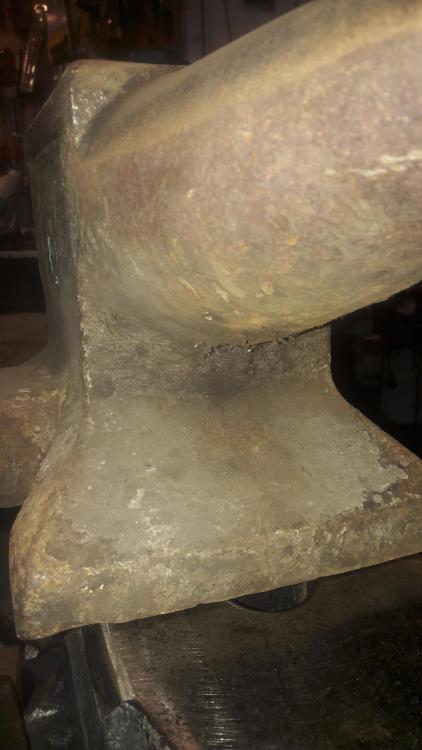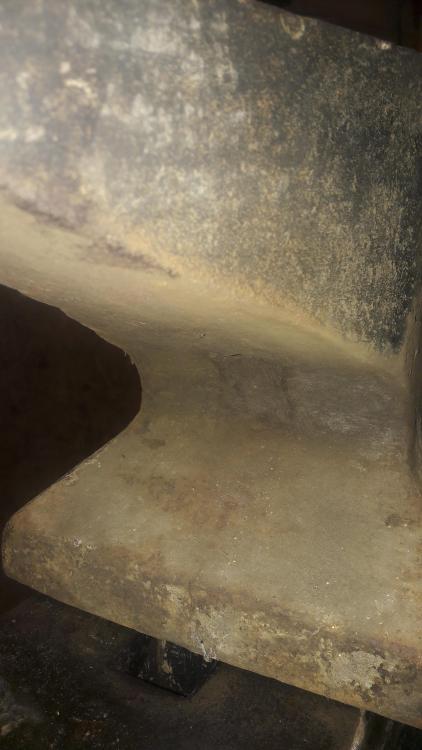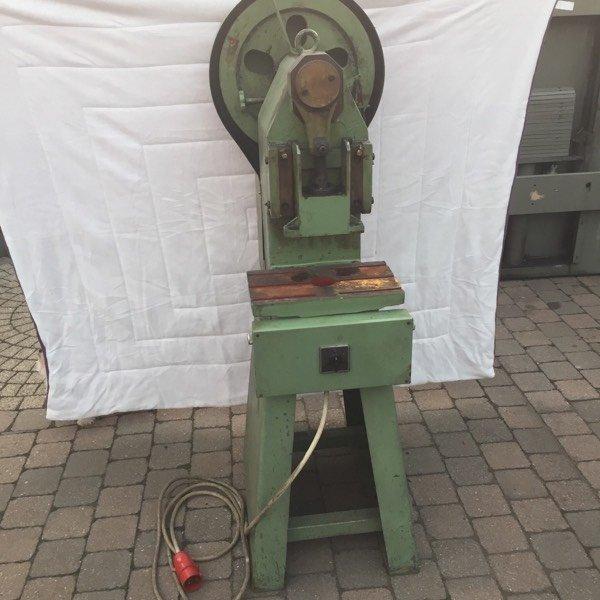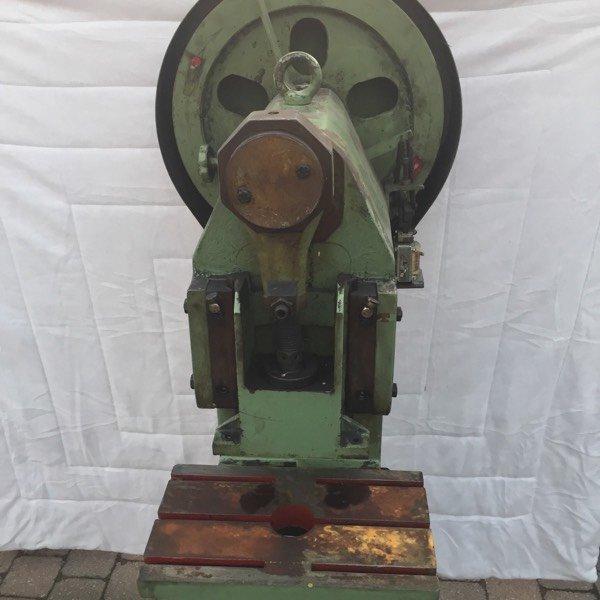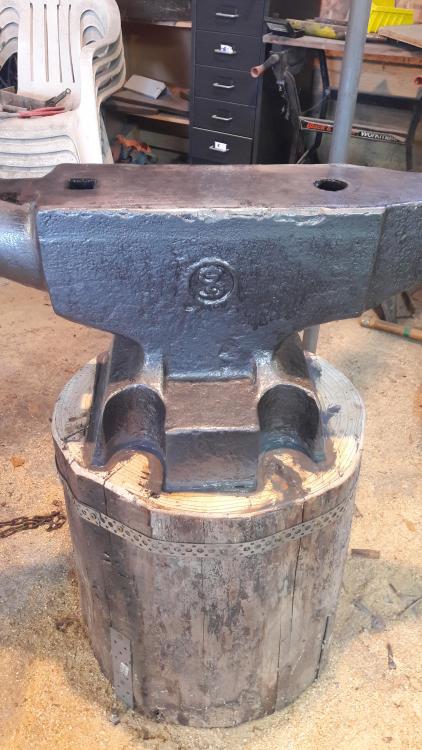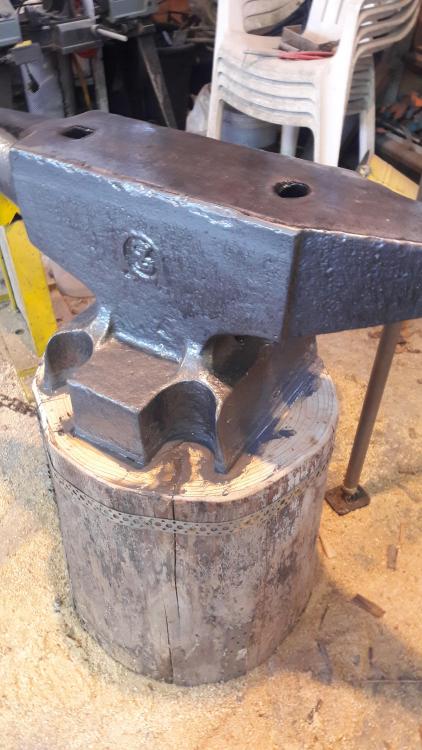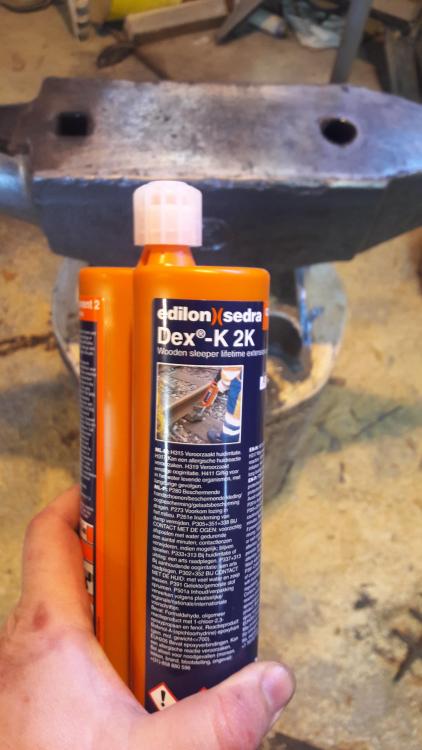
BartW
Members-
Posts
281 -
Joined
-
Last visited
Content Type
Profiles
Forums
Articles
Gallery
Downloads
Events
Everything posted by BartW
-
I think it's a repair. Someone had the vise, worn the treads down (altough that usually happens on the male side of the screw), or most likely simply lost that part. After that it's just a matter of making a mold, casting a cylindrical object in brass, then use a lathe to do the rest. I've seen one be made from aluminium entirely on a lathe. Nice vise tough.
-
Well, you can try with a small file, see if you can file into the top plate material near the crack, since if you're going to use this anvil, you might as well remove the cracked part. You could leave the corner (corner of the hardy hole to the start of the crack) to have something like a mini flat horn You shouldn't or barely be able to file the top plate since it should be hardened steel. But then run down the crack and do the same every inch or so. I think this is a one piece cast anvil. You'll either notice the same all over, or it reducing slightly in hardness going to the feet. This makes a very good anvil that your grandchildren can teach their grandchildren on how to forge. Unless you find a clear difference in the body and the top plate, those are very good anvils too (hardened faceplate). But than at least you know. I'd simply put her to use. Some minor grinding on the crack , face and horn, some wirewheeling all over, if you want to go fancy, you can even polish the face. Last, a couple good coats in linseed oil and you're good to go.
-
Question; how hard is the foot ? I've seen "fake" top plates before in cast steel anvils; and the crack seems to me to be a one piece anvil .. That's probably also why the hardy hole half broke off.
-
Deadening a smaller anvil
BartW replied to Drunken Dwarf's topic in Anvils, Swage Blocks, and Mandrels
Well I do agree silicone caulk will help; but not for the reasons you think. Silicone caulk fixes the anvil in place, but keeps the anvil as a single object with a resonance. The harder it is fixed to a stump, the more it will become "one" object, and "one" object made from different resonanting materials cancel the sound out. I'd bet that if you use hard epoxy instead of silicone caulk, it'll even become less noisy. I tried it already on two identical (loud) cast very hard tool steel anvils, and I posted it here on the forums (glueing anvils down ). So I'd say try and make your anvil into a as homogenous and heavy as possible object, and don't consider a bolt or a strap enough to make it "one" object. on my mobile anvil, which I refuse to fix to my stand, I use a polyurethane rubben 3 mm sheeth; but it's nowhere near as efficient to deafen an anvil as glueing it down to a wooden block. -
Cracked anvil...bought it really cheap!
BartW replied to caotropheus's topic in Repairing and Modification to Anvils
I've seen anvils like these being made in Turkey when I went and visited the Sahinler factories. Normal soft iron body in 5 pieces forgewelded together, with a steel plate on top which is hardened. There were pictures in the factory tour where they forged these together. I couldn't find any markings on them either. However, regardless of the manufacturer of your anvil, I'd assume a plain iron or mild steel forged welded together body with a hard plate the equivalent of C80 or 1085 steel. greetings, Bart -
That Belgian guy referred to could be me. I have 2 of these babies; shown here : https://www.iforgeiron.com/topic/57774-anvil-from-the-railway-workshop/ https://www.iforgeiron.com/topic/61365-anvil-twins/ From what I guy from the Skoda foundry guy, these are cast tool steel anvils (it looks like a faceplate, but it is in reality a grind line from the tooling), and the steel is the same steel used for battleship guns. They are extremely hard - a file doesn't even scratch it. The foot on mine is made specific to this shape to have 4 large locking bolts holding the anvil down in naval usage. mvg; bart
-
Cracked anvil...bought it really cheap!
BartW replied to caotropheus's topic in Repairing and Modification to Anvils
If you have welding experience, it is very tempting to clean out the crack and start welding at it. I know, I've been in the excact same situation. But trust me, it's a LOT harder to do this welding correctly than it seems. Also, I don't think it's worth it, since nothing you can do will improve the anvil. Just use it as it is; and if you do manage to break off that part; then worry about welding it back. About the hardy hole; I'd put it under my drill press, use the biggest diameter hole I could get without touching the square side, and drill entirely through, then chisel of file the rest. I assume you have tried simply beating it out -
Cracked anvil...bought it really cheap!
BartW replied to caotropheus's topic in Repairing and Modification to Anvils
Looks like a forged iron with a steel plate on top. If the crack doesn't go through the steel plate, I wouldn't worry about it at all. It looks like a fine anvil. About it not having a ring, don't worry about it either; a high pitch ring is good to drive you nuts and deafen you after a while. If you have many anvils; you will notice you will almost always tend to use the least noisy; unless you really really need another one for some reason. Mass under the hammer is the only thing that really matters; while rebound and hardness are only helpfull if you plan to miss often (less damage to the anvil). -
Well the offset idea is there, but to the right (which makes more sense if working with angle grinders). This one is more like a vise and less like a machine clamp. While mine is more of a hybrid. Mysterious vise...
-
Some fun welding. I'll have to turn the straps into something more "blacksmithy" but they work. Half inch thick mild steel. Hard rubber padding to absorb sound.
-
Hello all, I found this strange vise, 4 inch replaceable Jaws, it looks like a good machinist vise, except all the jaw is moved to the left. Also the screw and nut are strange, the screw is one long threaded rod, but the nut is like a pipe screwed on the back. There's thread inside all along the length. Tolerance is very small - machine clamp small. The whole thing is steel (checked with hardness files after i tried and failed to drill a holes). Also the rails have this bronze looking bar in a slot which you can adjust just like a adjustable cross-slide on a lathe or mill. The bottom is completely flat. Opens fairly far for such a small vise. Anyone know where these come from and why they are made like this?
-
hello guys; I have a question concerning ribbon burners. I've seen how most are made; and all cast a block of refractory cement with straws or some other means of making holes in it; then attach it to a metal casing in which the gas/air mix is pushed, most often by a blower; but it's also possible naturally aspirated. In my position, I got plenty or basically any kind of steel/ iron / cast iron. But refractory cement ... is fairly pricy, especially the good stuff. Now suppose I don't feel like mixing refractory cement, and replace the hole-block part with a 1 inch thick cast iron plate full of holes... or 2 inch .. or a mild steel plate. Of course, I'm going to make sure that plate doesn't touch the metal box in the back to limit heat by convection by separating it with a insulating fibre board rated for verrry high temperatures (1260 °C) . The cast iron gets "cooled" on one side by the cold gas/air mix; and heated on the other side by the inside of the forge. This limits the cracking problem with casting refractory. And replacing the face plate when it's worn is not really a problem; 10 minutes with an angle grinder, and 20 minutes on a drill press. Also, my forge is mostly used on weekends, and I really like the "silence" of ribbon burners, as opposed to the roaring of my current venturi burners. Is that even possible ? Or is this a bad idea for some reason I'm missing ? mvg; Bart
-
Hello; Well the overhang is already gone in this one I don't like the look of it either. Do you happen to know this brand ? i've never heard of it. Yet it seems a good portable anvil. mvg; Bart
-
It'll probably be a live fire demo - let the kids hammer a hook - kinda thing. And there will be some PR, you can be sure of that. Well I'm looking into making a mild steel tripod stand; and some brackets to bolt it down. Frosty, you are right, I haven't done any real blacksmithing yet, but I kinda rolled into it from bladesmithing. And xxxx no, these aren't going to be garden ornaments, I'd rather ship them to Alaska where they can be put to good use . My workshop is kinda the strange place you go to when you need something fixed, but don't want to go the official way. Weld something to a tractor; make a reduction rind for tool X ... But also for bladesmithing courses, or simply having your kitchen knives sharpened .
-
Hello All; at my wife's work (large hospital) they are organizing a fair for a whole weekend in the summer, and the topic this year is old crafts. As such, she assigned me to do the blacksmithing stand. Something I have never done before, and wasn't really planning on doing either due to lack of free time. Naturally I resisted a little bit, and I said that I have no "moveable" blacksmithing gear. My twin anvils are over 300 pounds each, my forging table is over 200 pounds .... She told she figured I was going to say that (she's a doctor, and smarter than me), so she asked around for mobile blacksmithing gear, and lo and behold one of her colleagues had an anvil lying around in his garage which I just had to collect. She also told me that she had seen a coal forge in pieces in my garage, that could be made mobile. So now I'm doing a blacksmithing stand for a weekend this summer ... But this is about the anvil. I fetch it at her colleagues and it strikes me as "odd". First, I had never heard of the brand before, marked VM and a 4 on the other side (and I've seen quite some anvils). Second, it's construction is ... puzzeling. I don't know the weight (yet) but I can walk short distances with it, and I'm a fairly big guy; so it has to be over 50 kg or 110 pounds. First off, it has casting marks (the split lines from the parts of the mold). The "face plate" seems to cover only the middle part of the top; and is obviously milled - it extends 3 to 4 mm wider than the body. but it stops in the square horn ... all the anvils I've seen in european style with a face plate had the plate running all the way through the square horn. If I fetch my hardness files; it becomes even weirder. Other than the obvious line on the side of the faceplate, I can find any edge of the faceplate. even the body below the faceplate is equally hard. On the sides of the square horn you can see chips missing just like there were on the side of the faceplate. also both horns are equally hard. Granted; they are not HRC 60 + like the skoda anvils; but they are above HRC 55. foot to top. Which begs the question; what's the fake faceplate doing there ? It seems to me to be a perfectly usable solid cast steel anvil; why go through the effort of "simulating" a face plate ? Anyone know this brand by any chance ? movie with anvil sound & rebound : https://drive.google.com/open?id=1hgnjp-JjAMshZvcHYNq5Lcu3RDeMd42a
-
Incredible. are there still people like this around ? You know what happens to zinc, brass and the like in an electric arc furnace for recyling steel ? And knitting steel together ... i'd say get that man a microscope and show me what isn't together in fresh 5160, and after you've folded it a couple times how bad it looks. Fresh 5160 is very clean uniform steel. But if he's so convinced, let him pass a ABS test or compete in a cutting competition ? We live in a golden age of steel. There is more steel around in much better quality then ever before. If the historical japanese smiths had access to the modern steel we have today for a couple of centuries; all the mythological katana's would have been mono steel, probably without hamon. Why fold it if it's perfect to start from ?
-
Hello All; I found an excentric press - it's not mine (yet) -, but it's for sale. But looking at the pictures, I thought If I add a linkage to make the excentric less rigid attached to the "punch", add a mechanism to control speed of the flywheel and an anvil; wouldn't that make this thing a small power hammer ? I mean it's already got most parts up to industrial specs like the drive wheel; the axle, the excentric, the guides ..
-
my anvil(s) in the far corner of Belgium. https://www.iforgeiron.com/topic/61423-glue-to-hold-an-anvil-down/
-
Check out the difference in sound. Same anvil, same hammer, even same wood for a stand from the same tree. Just different method of securing. The first one painted gray is glued on, the second has fysical mountings. 20190218_164156.mp4
-
Well, today I tried to "pull" the anvil off the wooden stump by attaching a chain block to the round hardy hole and pulling it up. Hoping to shear the glue on that side. Result: nope. The ligt angle iron holding the stump on the concrete (there's 4 of m), bent open and the stump lifted. Strange observation though, yesterday the glue was like epoxy - hardening like a hard brittle plastic - today it seems more like hard silicone rubber. It is also impossible to remove from wood, unlike epoxy it seems to bond with the wood. I also find myself favoring this anvil over the other one. Could be because it's lower or doesn't ring anymore.. Or both. Sooo I'll continue to use it. In a couple weeks I'll start "destructive" testing. Mvg Bart
-
Having asked a similar question before, the answer is you cannot have enough (except when running out of room to put them) , there is an optimal based on your work. I got too much so I end up giving them away to "sponsor" beginning Blacksmiths and bladesmiths. Greetz, Bart.
-
New Anvil radius the edges, how much
BartW replied to tughill's topic in Anvils, Swage Blocks, and Mandrels
My anvils have several radii all over. I know on the old one pretty much where what radius is, on the new one not so much yet. I don't think I could work with one uniform radius all over. It would look better though. Mvg Bart -
Well I got a box of those double tubes, they say there shelf life is 20 years so I'm OK in the glue department. :-) I added a picture of the glue in question, on the bottle there a picture of it's intended use. Seems to harden fast at first, then slower. Full hardness after 6 hours. I've been beating at the anvil with a sledgehammer (axe making). Doesn't move, no cracks yet. I'm beginning to think the weak part is the stump of pine wood... Mvg Bart
-
Hello all, There's a crate of beer in a bet here. Buddy of mine gave me a epoxy-ish glue, which is made to glue steel plates to (worn) wooden beams for train track construction. It's not for glueing rails down, but the plates where the rails are screwed on. Seems to be strange glue. It's ignorant to water, but penetrates wood & rusted steel like crazy (like the underside of the base of my anvil). Anyway, he told me it would hold down an anvil. I told him I'd get him a crate of beer if that would work. Hence the wager. My buddy didn't even used lots of glue. We decided I'd use it for a month, see if I could get it to loosen up. I got to keep the rest of the glue, so I got a couple liters of this glue now. Might also be good for attaching hamer heads to handles... Now I have a stump of wood, sanded flat, with a heavy flat based anvil glued to it. Secured to the concrete floor. Any thoughts how long this will last? Also the dampening effect of this is spectacular. Much less noise. Mvg Bart
-
Hello; Do you mean this guy : Commercial link removed Hefty prices indeed, lowest is around 1500$.
